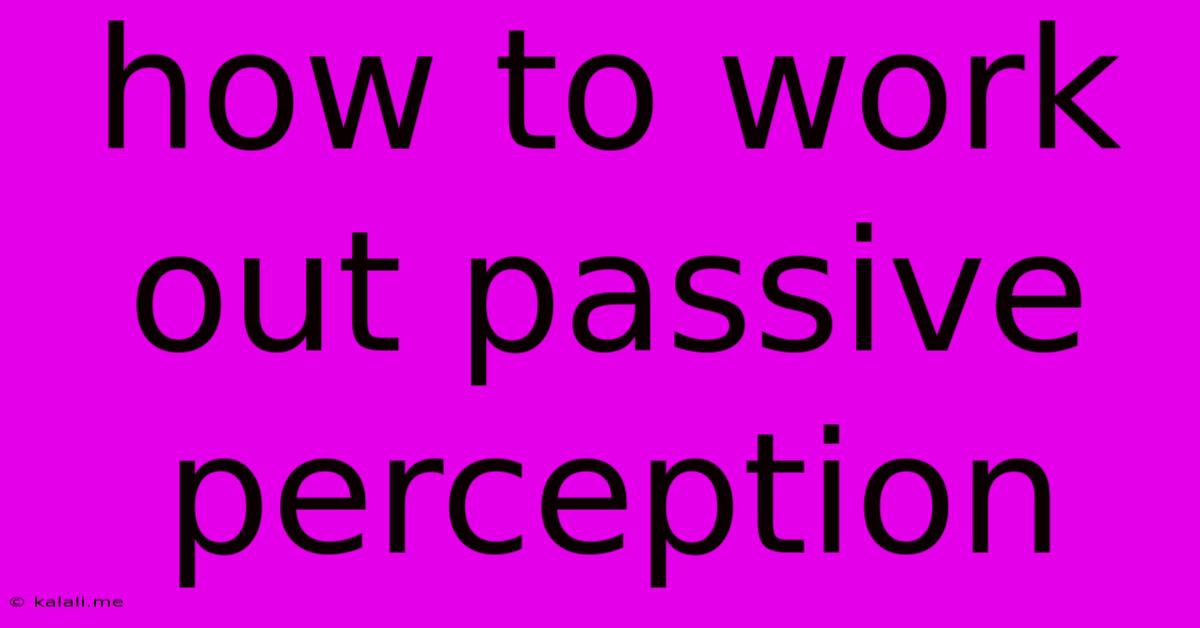How To Work Out Passive Perception
Kalali
May 20, 2025 · 3 min read

Table of Contents
How to Sharpen Your Passive Perception: A Guide to Enhanced Awareness
Passive perception, the ability to subtly pick up on details and cues in your environment without actively focusing on them, is a crucial skill in many aspects of life. Whether you're a detective piecing together clues, a negotiator sensing unspoken tension, or simply navigating social situations more smoothly, honing your passive perception can significantly improve your effectiveness. This article will guide you through practical exercises and strategies to enhance this often-overlooked skill. It’s about improving your situational awareness and developing your intuitive abilities.
What is Passive Perception?
Passive perception isn't about actively listening or observing; it's about allowing your senses to passively absorb information from your surroundings. It's the subtle awareness of body language, tone of voice, environmental changes, and unspoken cues that often escape conscious attention. Think of it as your subconscious constantly scanning for relevant data, providing you with a richer understanding of your surroundings than you might consciously realize. Improving passive perception is about training your brain to better process this influx of unconscious information.
Exercises to Enhance Your Passive Perception:
Here are some practical exercises you can incorporate into your daily life to sharpen your passive perception:
1. The Observation Game:
- Find a public place: Choose a location with moderate activity, like a café or park.
- Passive observation: Sit quietly and simply observe your surroundings without focusing on anything specific. Let your senses passively absorb the sights, sounds, and smells.
- Mental note-taking: After a few minutes, try to recall as many details as possible: the color of someone's shirt, a specific conversation fragment, the type of car that drove by.
- Repeat regularly: Practice this exercise for 10-15 minutes daily, gradually increasing the duration and complexity of the environment. This improves your ability to retain and process sensory information subconsciously.
2. The Body Language Challenge:
- Observe people: Pay close attention to people's body language in various situations. Focus on subtle cues like micro-expressions, posture shifts, and hand gestures.
- Contextualize: Try to understand the meaning behind these cues in context. Is someone nervous, happy, or annoyed?
- Reflective practice: After observing, reflect on what you noticed and whether your interpretations were accurate. This helps you calibrate your perception. You can even try guessing their emotions and then confirming (or correcting) your assumptions later.
3. The Sensory Detail Exercise:
- Focus on one sense: Choose one sense – sight, hearing, smell, taste, or touch – and focus on it intensely for a few minutes.
- Describe details: Describe the details you perceive in as much detail as possible. If it’s sight, note colors, shapes, and textures. If it’s sound, notice the pitch, volume, and rhythm.
- Rotate senses: Repeat this exercise, focusing on a different sense each time. This helps improve the sensitivity of individual senses and the integration of multiple sensory inputs.
4. Mindfulness and Meditation:
Regular mindfulness practices can significantly improve passive perception. Meditation encourages you to become more aware of your internal and external experiences without judgment, thus enhancing your ability to pick up subtle cues. The increased awareness translates directly into sharper passive perception.
Improving Passive Perception in Daily Life:
- Minimize distractions: Create space for quiet observation by reducing external noise and stimuli.
- Active listening: While seemingly contradictory, active listening improves your ability to pick up on unspoken cues. It enhances your attention to detail and improves your focus, which indirectly benefit passive perception.
- Practice empathy: Trying to understand others' perspectives enhances your awareness of their emotional states and subtle cues.
By consistently practicing these exercises and incorporating mindfulness into your daily life, you can significantly improve your passive perception, leading to enhanced awareness, improved decision-making, and stronger interpersonal skills. Remember that developing passive perception is a journey, not a destination. Consistent effort will yield significant improvements in your awareness and intuition.
Latest Posts
Latest Posts
-
Can You Take Aerosol Cans On An Airplane
May 21, 2025
-
Why Is My Led Light Bulb Flickering
May 21, 2025
-
Why Does My Airpods Case Keep Beeping
May 21, 2025
-
Solid White Line On Side Of Road Parking
May 21, 2025
-
What Is A Sill On A Car
May 21, 2025
Related Post
Thank you for visiting our website which covers about How To Work Out Passive Perception . We hope the information provided has been useful to you. Feel free to contact us if you have any questions or need further assistance. See you next time and don't miss to bookmark.